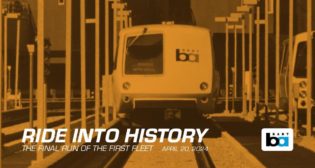
First new PATCO railcars unveiled
Written by William C. Vantuono, Editor-in-ChiefPATCO plans to conduct functional and on-track evaluations of the two prototype cars, along with six others yet to arrive from the Alstom assembly facility in Hornell, N.Y. The agency will then introduce the cars into revenue service and use them as templates for the rest of the production run, which is scheduled for completion by the end of 2016.
The railcar overhaul project is expected to cost about $194 million, approximately $70 million of which will be funded with federal dollars. The project is largest rolling stock capital expenditure since PATCO’s inception in 1969 and one of the largest capital improvement projects in DRPA (Delaware River Port Authority) history.
In 2012, PATCO separated 26 cars from their undercarriages and transported them by truck to Alstom, where they were stripped down to their steel outer shells and rebuilt from the outside in. The two newly refurbished prototype cars arrived in Lindenwold on the weekend before Thanksgiving.
New interiors, designed by industrial designer Carlos Pilonieta, feature brighter colors, higher ceilings, slip-resistant floors, and new seats for greater passenger comfort. With thicker windows, better weather stripping and brand new heating and air conditioning systems, the refurbished cars will be cooler during the summer and warmer in the winter, PATCO said.
The cars also have a new wheelchair and bicycle parking area with flip-up seats. For greater security, a new passenger alarm system includes an intercom that allows passengers to communicate with the train operator. The cars also are equipped with interior security cameras connected to an externally accessible DVR.
The braking system, improved to allow for reduced stopping distance and more stability, features regenerative braking that conserves power by returning braking energy to the propulsion system. PATCO operators should find the cars more user-friendly, as they feature full-width cabs, touch-screen communication inputs, and cockpit consoles that provide real-time operational information.
The cars also include a number of new communications systems: a new public address system with automatic announcements; a noise-sensing microphone and better speakers; external speakers where announcements made from the train can be heard on the platforms; scrolling exterior destination-and-route signs; and a video advertising and infotainment system.
“Our first cars have come home for the holidays, and they look great,” said PATCO General Manager John Rink. “They’re bright, spacious, gleaming, and furnished with new equipment that promises to make PATCO travel more comfortable, reliable, and secure than ever.”
PATCO entered passenger rail service in 1969 with 75 railcars manufactured by Budd. In 1980, PATCO added 46 cars made by Vickers. Both classes of car are scheduled for overhaul.



